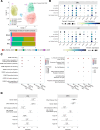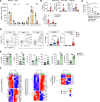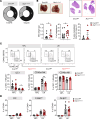Cxcr3 promotes protection from colorectal cancer liver metastasis by driving NK cell infiltration and plasticity
- PMID: 40168086
- PMCID: PMC12126236
- DOI: 10.1172/JCI184036
Cxcr3 promotes protection from colorectal cancer liver metastasis by driving NK cell infiltration and plasticity
Abstract
The antimetastatic activity of NK cells is well established in several cancer types, but the mechanisms underlying NK cell metastasis infiltration and acquisition of antitumor characteristics remain unclear. Herein, we investigated the cellular and molecular factors required to facilitate the generation of an ILC1-like CD49a+ NK cell population within the liver metastasis (LM) environment of colorectal cancer (CRC). We show that CD49a+ NK cells had the highest cytotoxic capacity among metastasis-infiltrating NK cells in the MC38 mouse model. Furthermore, the chemokine receptor CXCR3 promoted CD49a+ NK cell accumulation and persistence in metastasis where NK cells colocalize with macrophages in CXCL9- and CXCL10-rich areas. By mining a published scRNA-seq dataset of a cohort of patients with CRC who were treatment naive, we confirmed the accumulation of CXCR3+NK cells in metastatic samples. Conditional deletion of Cxcr3 in NKp46+ cells and antibody-mediated depletion of metastasis-associated macrophages impaired CD49a+NK cell development, indicating that CXCR3 and macrophages contribute to efficient NK cell localization and polarization in LM. Conversely, CXCR3neg NK cells maintained a CD49a- phenotype in metastasis with reduced parenchymal infiltration and tumor killing capacity. Furthermore, CD49a+ NK cell accumulation was impaired in an independent SL4-induced CRC metastasis model, which fails to accumulate CXCL9+ macrophages. Together, our results highlight a role for CXCR3/ligand axis in promoting macrophage-dependent NK cell accumulation and functional sustenance in CRC LM.
Keywords: Cell migration/adhesion; Immunology; Innate immunity; NK cells; Oncology.
Conflict of interest statement
Figures








References
MeSH terms
Substances
LinkOut - more resources
Full Text Sources
Medical
Research Materials

